 |
|||||||||||||||
| St. Albans (GB) | |||||||||||||||
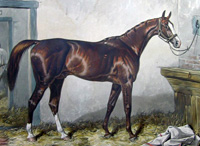 St. Albans Sire Line  Stockwell |
St. Albans ch c 1857 (Stockwell -
Bribery, by The Libel). Sire Line Stockwell.
Family 2-u. Bred by George William Frederick Brudenell-Bruce (1804-1878), 2d Marquess Of Ailesbury, St. Albans was described as "a rich dark-coloured chesnut horse, with a white blaze in his face, and two white heels behind. Standing about 15 hands two inches high. His head is very neat and bloodlike, has a clean neck and good shoulders, is not very deep in his girth, or powerful in his middle, but has a good back, quarters a little straight, and strong thighs and hocks, not over large knees, but good bone, with long springy pasterns. He carries himself rather gaily when out, and is in points very like his sire, with more length, and showing more breeding". His temper was considered doubtful and he was thought dangerous to strangers. His dam, Bribery (ch f 1851) won the Goodwood Stakes herself, and got his half brother Compromise (b c 1855 Alarm) who went to Austria, and his full brother Savernake (ch c 1863) who became a champion sire in Germany. The offspring of Bribery were thought to be "delicate of constitution; and St. Albans, himself, required extreme care during the winter preceding his two-year-old season, owing to a weakness in his knees, and he could never be relied upon for two days together". |
||||||||||||||
|
|
|||||||||||||||
|
|||||||||||||||
|
|
|||||||||||||||
| St. Albans ran for 2 years, starting 8
times and winning 5 races. After he won the Tradesman's Cup (also called
the Chester Cup) he was unsound and withdrawn from the Derby. His
outstanding win in the St. Leger made his reputation for him, as the
splendid Thormanby was left in the field. In 1860 he finished 2° for the 8f Column Stakes at Newmarket, won by Lord Derby's 1000 Guineas winner Sagitta (b f 1857 Longbow), beating Lord Strathmore's Leprochaun (ch g 1857 Daniel O'Rourke). Next he won the ~18f Great Metropolitan Stakes at Epsom by a length and a half, beating J Gibbs's Wallace (ch c 1857 Malcolm) and Mr Lambert's Clydesdale (br c 1855 Annandale). He then won the 8f Newmarket Stakes by 4 lengths, beating Mr Merry's Northern Light (gr c 1857 Chanticleer) and Mr Hare's Hartley Wintney (b c 1857 Bay Middleton). He followed that with a win in the ~18f Tradesman's Plate at Chester by a length, beating W Day's Petra (b f 1856 Tadmor) and Lord Portsmouth's Tame Deer (b g 1853 Venison). He got a big win in the 16f St. Leger Stakes at Doncaster by a length and a half, beating Mr Jacques's High Treason (ch c 1857 Mildew), A Nichol's 2000 Guineas winner The Wizard (b c 1857 West Australian) and Lord Zetland's Doncaster Cup winner Sabreur (br c 1857 Voltigeur). Among the field were the Derby winner Thormanby (ch c 1857 Windhound), Stewards Cup winner Sweetsauce (ch c 1857 Sweetmeat), King's Stand Stakes winner Umpire (ch c 1857 Lecomte), July Stakes winner Buccaneer (b c 1857 Wild Dayrell), and Champagne Stakes winner King Of Diamonds (ch c 1857 King Tom). In his last outing for the year he finished 4° of 4 for the 12f Doncaster Stakes, won by Lord Derby's Cape Flyaway (br c 1857 The Flying Dutchman), Mr Parker's Sutherland (b c 1857 Grosvenor) and The Wizard. In 1861 he won the Ascot Triennial Stakes by 6 lengths, beating King Of Diamonds, Mr Gratwicke's Coronation Stakes winner Allington (ch f 1857 Chatham) and Lord Ailesbury's Plumper (ch f 1857 Rataplan). He broke down in his next outing, the ~20f Gold Cup at Ascot, won by Thormanby, Mr Cartwright's Fairwater (b f 1858 Loup-Garou) and Mr Savile's Queen's Vase winner Parmesan (br c 1857 Sweetmeat). He retired to Bushy, or Bushey, Paddocks at Hampton Court. His fee was 20 guineas. Trumpeter (ch c 1856 Orlando) was there as well. His important contribution to the world of bloodstock breeding was his son Springfield (b c 1873). Other sons, like Julius (b c 1864) who won the Cesarewitch, Martyrdom (ch c 1866) who won the Prince Of Wales's Stakes, and Proto-Martyr (ch c 1869) who won the Brighton Stakes, had a limited success in the stud. Other offspring of interest include (1) Countess Amy (bbr f 1863), grandam of Cesarewitch winner Hilarious (br c 1874 Brown Bread) and Goodwood Stakes and Great Yorkshire Handicap winner Reveller (br c 1876 Brown Bread) (2) Duchess (br f 1864), winner of the Nassau Stakes and grandam of Wagner (b c 1882 Prince Charlie) who was sent to America and did well there as a stallion (3) First Lady (b f 1865), dam of the great Australian-bred Grand Flaneur (b c 1877 Yattendon), winner of the Melbourne Cup and both the Australian Derby and the Victoria Derby (4) Lady Grace (ch f 1865), dam of Recorder (ch c 1872 Hermit) who went to Germany and got the Mehl-Mülhens-Rennen winner Königswinter (gr c 1890) (5) La Belle Hélène (br f 1866), grandam of the magnificent Perdita (b f 1881 Hampton), she the dam of St. Jamess's Palace Stakes winner Florizel (br c 1891 St. Simon), Derby, St Leger and Ascot Gold Cup winner Persimmon (b c 1893 St. Simon) and triple crown winner Diamond Jubilee (b c 1897 St. Simon) (6) Albania (br f 1876), dam of the Poule D'Essai Des Poulains winner Le Hardy (ch c 1888 St. Louis). |
|||||||||||||||
| Springfield (GB) | |||||||||||||||
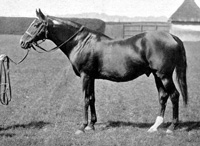 Springfield  Joseph H Houldsworth, was a great sportsman and member of the Jockey Club. Early on he acquired horses from James Merry, and numbered among his racing string such horses as Norfolk and Great Yorkshire Stakes winner Coltness, Prince Of Wales's Stakes winner Glengarry, Sussex Stakes winner Orvieto and Champion and Jockey Club Stakes winner Laveno. |
Springfield b c 1873 (St. Albans -
Viridis, by Marsyas). Family 12-c. Bred by HM Queen Victoria (1819-1901), Springfield was a full brother to Wokingham (b c 1877), aptly named since he won the Wokingham Stakes at Ascot in 1881 and 1882. Their grandam, Maid Of Palmyra (b f 1855), also produced Ebor Handicap winner Verdant (ch c 1862 Marsyas) and another Wokingham winner Chesnut (ch c 1869 Marsyas). She was ancestress to Belmont Stakes winner Kingfisher (b c 1867 Lexington) and July Cup, Queen Anne Stakes and King's Stand Stakes winner Best Man (b c 1890 Ormonde or Melton). He was purchased at the annual Hampton Court yearling sale by inverate Scotsman J H Houldsworth for 320 guineas. Shortly after his purchase he fractured his pelvis, but he was recovered enough to run the following year. Springfield was later described as a "bay with a narrow blaze on his face, and his off hind heel is white. He stands over 16 hands, with great bone, substance and length, and grand symmetry throughout. For bloodlike style, fashion and movement he has no superior, and he has gained his honours fairly on his merits". He was considered one of the fastest horses ever seen. |
||||||||||||||
|
|
|||||||||||||||
|
|||||||||||||||
|
|
|||||||||||||||
| Trained by James Ryan at Green Lodge,
Springfield ran for 3 years, starting 19 times and winning 17 times,
earning £8,720. As a
2 year old he won 3 of 5, and finished 2° for the other 2. He never lost
again. As a 3 year old he did not contest the classics but embarked upon
an odd, if not bizarre, selection of races, most of them sprint length,
often with only 1 or 2 rivals and mostly his competition was a long way
from his class. As a 4 year old his schedule was more orthodox and he
reaffirmed he could win easily at a longer distance. In 1875, running for Mr Houldsworth, he won the 5f+ Prince Of Wales's Stakes at York by 2 lengths, beating R Peck's Forerunner (b c 1873 The Palmer) and C J Bedford's Hoyden (ch f 1873 See Saw). He then won the 6f Gimcrack Stakes the next day, by 3 lengths, beating Mr Bowes's Twine The Plaiden (b f 1873 Blair Athol) and Lord Durham's Glendale (ch c 1873 Blair Athol). Then he won the 4f Two Year Old Stakes at Newmarket First October by 4 lengths, beating Prince Batthyany's Geryon (ch c 1873 Typhoeus) and M Dawson's Bella (ch f 1873 Breadalbane). He finished 2° for the 6f Criterion Stakes at Newmarket, won by Lord Lascelles Clanronald (b c 1873 Blair Athol) by a head, beating Lord Falmouth's Farnese (ch c 1873 Parmesan). In his last race of the year he finished 2° for the 7f Dewhurst Plate at Newmarket, won by Alex Baltazzi's Kisbér (b c 1873 Buccaneer), by 3 lengths, beating Lord Durham's Glendale. In 1876 he won the 5f Fern Hill Stakes at Ascot by 4 lengths, beating Lord Rosebery's Rosbach (b c 1874 Victorious) and Jos Dawson's Bruce (b c 1874 King O'Scots). The next day he won the 5f+ New Biennial Stakes by 6 lengths, beating H Bird's Concha (br c 1873 Asteroid). He next won the 5f Stockbridge Cup by 3 lengths, beating H Bird's Lowlander (ch c 1870 Dalesman) and F Hardinge's Chesterfield (b c 1874 Fitz-Ivan). He then won the 6f July Cup at Newmarket by 12 lengths, beating the Duke Of St. Albans's Crann Tair (b f 1874 Lord Lyon) and Count F De Lagrange's Echanson (ch c 1874 Consul) who bolted and was not placed. Following this he won the 5f Bognor Stakes at Goodwood by 3 lengths, beating Sir F Johnstone's Caesarion (b c 1874 Julius). He then won the 5f+ Bradgate Park Stakes at Doncaster, beating R N Batt's Meta (ch f 1874 Rataplan or Strathconan) by 4 lengths. The next day he walked over for the 6f Eglinton Stakes. He also wallked over for the 8f Select Stakes at Newmarket. His final race of the year was a win for a 12f+ Free Handicap at Newmarket by three quarters of a length, beating Count F De Lagrange's Gavarni (b c 1873 Marcello), Mr Gomm's Advance (b c 1873 Speculum) and J N Astley's Sailor (br c 1873 Suffolk). In 1877 he won the 5f Queen's Stand Plate at Ascot by 4 lengths, beating M Lefevre's Ecossais (ch c 1871 Blair Athol) and Captain Machell's Warrior (b c 1874 General Peel). He also won 5f+ New Biennial, still at Ascot, by 4 lengths, beating Rob Roy (ch c 1874 Blair Athol) and Lord Calthorpe's Monachus (ch c 1874 Hermit). He then won the 6f July Cup at Newmarket by 3 lengths, beating the Duke Of Hamilton's Lollypop (ch c 1873 Souvenir), Captain Prime's Trappist (b c 1872 Hermit) and Ecossais. He next won the 10f Champion Stakes by a length, beating Lord Falmouth's Derby and St Leger winner Silvio (b c 1874 Blair Athol), Lord Falmouth's St. James's Palace Stakes winner Great Tom (ch c 1873 King Tom), C Alexander's Thunderstone (ch c 1874 Thunderbolt), Lord Lonsdale's Hesper (b c 1873 Speculum) and 3 other 3 year olds. Springfield and Great Tom carried 9st 4lb, and Silvio carried 8st 6lb. And finally he won the All Aged Stakes at Newmarket, beating Ecossais. At his retirement from the turf he was secured by Colonel Sir George Maude, Crown Equerry, for the royal stud. He commenced his stud career in 1878 for a fee of 100 guineas, which later rose to 150 guineas then to 200 guineas. For 1896 he was relocated to Houldsworth's Green Lodge paddocks at Newmarket and covered for a fee of 200 guineas. Probably his best son was Sainfoin (ch c 1887), see below. Another was Watercress (br c 1889), owned by Baron De Hirsch, who won the Prince of Wales's Stakes and the Hardwicke Stakes, both at Ascot. He was purchased by James B Haggin and sent to Rancho Del Paso in California. There he became a good and useful stallion. Springfield got a number of good mares as well, including (1) Briar-Root (b f 1885), bred by HM Queen Victoria and owned by Douglas Baird, she won the 1000 Guineas Stakes and the Yorkshire Oaks. She was ancestress to Dewhurst and Sussex Stakes winner Hurry Off (b c 1920 Hurry On) and the Deutsches Derby and Mehl-Mülhens-Rennen winner Prunus (b c 1915 Dark Ronald) (2) Sundown (b f 1887), sent to America, was the ancestress of Futurity and Hopeful Stakes winner Campfire (ch c 1914 Olambala), Argentine Oaks and 1000 Guineas winner, Black Arrow (bl f 1931 Silurian), who produced 2 classics winners, Argentine Oaks and 1000 Guineas winner Blackie (b f 1938 Congreve) and Argentine 2000 Guineas winner Black Out (b c 1940 Rustom Pasha). Sundown was also ancestress to American champion Stymie (ch c 1941 Equestrian) and Belmont winner and champion High Gun (br c 1951 Heliopolis) (3) Sierra (ch f 1889), bred by HM Queen Victoria, she was a full sister to the Derby winner Sainfoin (ch c 1887), she was ancestress to a number of good winners, including Cesarewitch winner Black Sand (b c 1897 Melanion), Caulfield Cup winner Lucknow (ch c 1914 Minoru), Melbourne Cup winner Catalogue (b g 1930 Lord Quex), Irish Derby winner Raeburn (bbr c 1933 Solario), but mainly she is notable as the dam of champion stallion Sundridge (ch c 1898) (4) Pastorella (ch f 1892), bred by Lord Zetland, was purchased by Marcus Daly and was sent to America. There she founded a family of runners, including Belmont Stakes winner Colin (br c 1905 Commando) and Metropolitan Handicap winner Wildair (b c 1917 Broomstick). The General Stud Book notes that Springfield "was shot" on March 31st, 1898. |
|||||||||||||||
| Sainfoin (GB) | |||||||||||||||
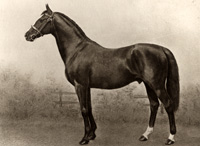 Sainfoin, Photograph by Clarence Hailey  HM Queen Victoria (1819-1901), re-established the breeding of blood horses at Hampton Court at the end of 1849. An annual sale of the Queen's yearlings occurred after the Ascot race meeting. A number of good stallions stood there and many high quality horses were produced. |
Sainfoin ch c 1887 (Springfield -
Sanda, by Wenlock). Family 2-g. Bred by HM Queen Victoria at Hampton Court, he was inbred to Stockwell (ch c 1849) twice in the third generation and was a full brother to Sierra (ch f 1899), the dam of champion sire Sundridge (ch c 1898 Amphion). Their 3° dam, Lady Evelyn (b f 1846 Don John) won the Oaks, Park Hill and Coronation Stakes. John Porter purchased him from the annual yearling sale at Hampton Court for 500 guineas for himself and Sir Robert Jardine. Porter was said to have doubts that Sainfoin could win the Derby but Sir James Miller was impressed with his performance early in his three year old season and paid £6,000 for him, plus half the Derby Stakes if he won. Sainfoin stood 16 hands and was described by Sir Richard Green Price as "medium-sized, level, true in his slow paces as in his fast; fine tempered and willing to do his best; not a smasher, but a wearer down of such as Surefoot, and his very looks tell you so as surely as a knowledge of horseflesh is your heritage". |
||||||||||||||
|
|
|||||||||||||||
|
|||||||||||||||
|
|
|||||||||||||||
| Sainfoin was trained by John Porter at
Kingsclere. He ran only once as a two year old. After his first win as a
three year old he was purchsed by Sir James Miller. He won the Derby from
Surefoot, who had already won the 2000 Guineas, and later a story arose
that Surefoot's jockey was "full of gin". After the St. Leger he went to
Newmarket for training. He
ran at four and five but did not win. In all he started 11 times and won 4
of these, earning about £8,450. In 1889, running for John Porter, he won the 5f Astley Stakes at Lewes by a length and a half, beating J Hammond's Garter (b c 1887 Hampton) and Mr Fawcett's Spring Cup (b c 1887 Springfield). In 1890 he won the 8f Esher Stakes at Sandown Park by 4 lengths, beating G Blewitt's Dry Toast (ch c 1887 George Frederick), J Lowther's Gimcrack Stakes winner Cheroot (ch c 1886 Peter) and General Byrne's Amphion (ch c 1886 Speculum or Rosebery). Sainfoin, Dry Toast and Cheroot carried 6st 11lb, 6st 5lb and 6st 9lb respectively, whilst Amphion carried 9st 2lb. Running for Sir James Miller he next won the 12f Dee Stakes at Chester by half a length, beating the Duke Of Beaufort's Bull's-Eye (ch f 1887 Petronel) whilst giving her 16 pounds. He then won the 12f Derby at Epsom by three quarters of a length, beating Baron De Rothschild's Dewhurst Stakes winner Le Nord (ch c 1887 Tristan), the Duke Of Westminster's Orwell (b c 1887 Bend Or), A W Merry's 2000 Guineas winner Surefoot (b c 1887 Wisdom), E W Baird's Richmond Stakes winner Golden Gate (b c 1887 Bend Or), James White's Australian-bred Kirkham (ch c 1887 Chester), Capt Machell's Wokingham Stakes winner Rathbeal (b c 1887 Boulevard) and Douglas Baird's Queen's Vase winner Martagon (b c 1887 Bend Or). He next finished 2° for the 12f Hardwicke Stakes at Ascot, won by Amphion (9st 10lb), beating Surefoot (8st 8lb), and Col North's City And Suburban winner Nunthorpe (b c 1886 Camballo) with 9st 7lb up. Sainfoin and Amphion were at equal weight. Next he finished 4° for the 14f+ St. Leger at Doncaster, behind the Duke Of Portland's Oaks winner Memoir (br f 1887 St. Simon), the Duke Of Westminster's Queen Alexandra Stakes winner Blue-Green (br c 1887 Coeruleus) and Mr Gretton's Goodwood Cup winner Gonsalvo (b c 1887 Fernandez). Among the field were future Doncaster Cup winner Queen's Birthday (b c 1887 Hagioscope), Martagon, Right-Away (b c 1887 Wisdom), Surefoot, Sussex Stakes winner St. Serf (br c 1887 St. Simon) and Baron Rothschild's Prix Du Jockey Club winner Heaume (ch c 1887 Hermit). In his final race of the year he was unplaced for a 10f Free Handicap at Newmarket, won by St. Serf and Martagon. In 1891 he finished 3° for the 8f Imperial Plate at Hurst Park, won by Jas Lowther's Heremon (ch c 1887 Master Kildare) and Warren De La Rue's Dearest (b f 1887 Hampton). He was unplaced for the 6f Isleham Plate at Newmarket, won by Prince Soltykoff's July Cup winner Woolsthorpe (b c 1888 Tibthorpe) and Lord Durhams Dunvegan (b c 1887 Theologian). In 1892 he was unplaced for the 8f Lincolnshire Handicap, won by Mr Blundell Maple's Clarence (bbr c 1889 Saraband) and T Jennings's Acrobat (ch c Trapèze), both 3 year olds. Clarence carried 6st 8lb, Acrobat carried 6st 1lb, Sainfoin carried 8st 11lb. 25 started. He was also unplaced for the 10f City And Suburban Handicap at Epsom, won by Lord Rosslyn's Ascot Gold Cup winner Buccaneer (b c 1888 Privateer) and G E Paget's Trapezoid (ch f 1888 Trappist). Buccaneer carried 7st 10lb, Trapezoid carried 7st 7lb, Sainfoin carried 8st 10lb. 22 started. In the 1892 racing calendar he was advertised to stand at Mr Barrow's Paddocks at Newmarket for the following year at a fee of 50 guineas. The next year he was at Hollist Stud Farm, Midhurst, and remained there for several years. For 1898 he went to the Sefton Stud Farm at Newmarket for 2 years where his fee was 48 sovereigns and dams of winners of 500 sovereigns at one time would be served for half price. He was advertised for 1900 season at the Hamilton Stud Farm at Newmarket for a fee of 30 guineas. After the death of Miller in 1906, he was purchased at auction by the 5th Earl Of Carnarvon. He covered at the Cloghran Stud in Co Dublin for a fee of 19 guineas for 4 years. He was then purchased by Messrs Slocock and covered at Carlow. His best son was of course Rock Sand (br c 1900), see below. Another son, Printonan (b c 1904) went to Sweden and got a number of classics winner in Scandinavia. Some of his daughters did fairly well for themselves, among them were (1) Grace Gumberts (ch f 1901), dam of Cambridgeshire winner Adam Bede (ch c 1908 Adam) and his half brother, Prix De La Foret winner Le Grand Pressigny (ch c 1911 St. Bris) (2) Toute Suite (ch f 1904), dam of St. Leger winner and champion stallion and champion broodmare sire Hurry On (ch c 1913 Marcovil) (3) Bromus (b f 1905), dam of champion stallion and champion broodmare sire Phalaris (br c 1913 Polymelus) and Hainault (br c 1914 Swynford) (4) Bunch Grass (b f 1907), ancestress of Australian super horse Ajax (ch c 1934 Heroic) who won 36 of his 46 starts (5) Cambric (b f 1910), dam of Champion Stakes winner Franklin (b c 1918 Volta), who got an Austrian Derby and Guineas winner in Bernadotte (b c 1935). Sainfoin died at Carlow in 1911, aged 24. |
|||||||||||||||
| Rock Sand (GB) | |||||||||||||||
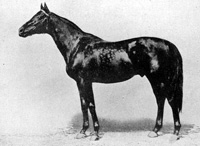 Rock Sand, Photograph by August Belmont  Sir James Percy Miller (1864-1906), 2d Bt, was considered one of the luckiest people on the turf. Having purchased Sainfoin just over a month before he won the Derby, he then bred another Derby winner in Rock Sand. |
Rock Sand br c 1900
(Sainfoin - Roquebrune, by St. Simon).
Family
4-n. The tenth winner of the Triple Crown in England, Rock Sand was described as a beautifully made little colt with much quality and courage. Sir James purchased his sire Sainfoin (ch c 1887) the same year he won the Derby. He purchased his dam, Roquebrune (br f 1893), as a yearling for 4,100 guineas from the disposal sale for the Dowager Duchess Of Montrose. |
||||||||||||||
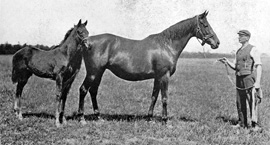 Roquebrune, Photograph by W A Rouch © Thoroughbred |
|||||||||||||||
| Roquebrune won the Norfolk Stakes by a head, beating the Duke Of Westminster's Shaddock (b c 1893 St. Serf) and the Prince Of Wales's 1000 Guineas winner Thais (br f 1893 St. Serf), also in the field was Leopold De Rothschild's Galeazzo (b c 1893 Galopin). His grandam, St. Marguerite (ch f 1879), won the 1000 Guineas and then produced Oaks and St. Leger winner Seabreeze (ch f 1885 Isonomy), Yorkshire Oaks winner Antibes (ch f 1886 Isonomy), Champagne Stakes winner Riviera (br f 1887 Isonomy) and Tredennis (ch c 1898 Kendal), among others. His pedigree suggested tremendous potential and he was certainly the best offspring of his sire. | |||||||||||||||
|
|
|||||||||||||||
|
|||||||||||||||
|
|
|||||||||||||||
|
Trained by George Blackwell at Newmarket, he ran for 3 years,
starting 20 times and winning 16 races. His most controversial race was
as a 3 year old when he was defeated by two exceptional 4 year olds, Ard
Patrick and Sceptre, for the Eclipse Stakes as the public had mistakenly
favoured Rock Sand. During his otherwise distinguished career he earned
£45,618. |
|||||||||||||||